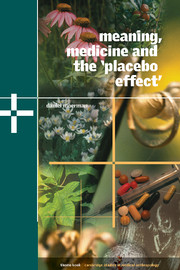28 results
The argument for single-purpose robots
-
- Journal:
- Behavioral and Brain Sciences / Volume 40 / 2017
- Published online by Cambridge University Press:
- 10 November 2017, e274
-
- Article
- Export citation
Cathedrals, symphony orchestras, and iPhones: The cultural basis of modern technology
-
- Journal:
- Behavioral and Brain Sciences / Volume 35 / Issue 4 / August 2012
- Published online by Cambridge University Press:
- 15 June 2012, pp. 231-232
-
- Article
- Export citation
10 - Other approaches: learning, expecting, and conditioning
-
- Book:
- Meaning, Medicine and the 'Placebo Effect'
- Published online:
- 05 June 2012
- Print publication:
- 17 October 2002, pp 122-126
-
- Chapter
- Export citation
1 - Healing and medical treatment
-
- Book:
- Meaning, Medicine and the 'Placebo Effect'
- Published online:
- 05 June 2012
- Print publication:
- 17 October 2002, pp 9-15
-
- Chapter
- Export citation
2 - The healing process
-
- Book:
- Meaning, Medicine and the 'Placebo Effect'
- Published online:
- 05 June 2012
- Print publication:
- 17 October 2002, pp 16-21
-
- Chapter
- Export citation
11 - Ethics, placebos, and meaning
-
- Book:
- Meaning, Medicine and the 'Placebo Effect'
- Published online:
- 05 June 2012
- Print publication:
- 17 October 2002, pp 127-130
-
- Chapter
- Export citation
7 - Psychotherapy: placebo effect or meaning response?
-
- Book:
- Meaning, Medicine and the 'Placebo Effect'
- Published online:
- 05 June 2012
- Print publication:
- 17 October 2002, pp 89-99
-
- Chapter
- Export citation
8 - The neurobiology and cultural biology of pain
-
- Book:
- Meaning, Medicine and the 'Placebo Effect'
- Published online:
- 05 June 2012
- Print publication:
- 17 October 2002, pp 100-115
-
- Chapter
- Export citation
Part I - The meaning response
-
- Book:
- Meaning, Medicine and the 'Placebo Effect'
- Published online:
- 05 June 2012
- Print publication:
- 17 October 2002, pp 7-8
-
- Chapter
- Export citation
List of tables
-
- Book:
- Meaning, Medicine and the 'Placebo Effect'
- Published online:
- 05 June 2012
- Print publication:
- 17 October 2002, pp xi-xi
-
- Chapter
- Export citation
References
-
- Book:
- Meaning, Medicine and the 'Placebo Effect'
- Published online:
- 05 June 2012
- Print publication:
- 17 October 2002, pp 156-168
-
- Chapter
- Export citation

Meaning, Medicine and the 'Placebo Effect'
-
- Published online:
- 05 June 2012
- Print publication:
- 17 October 2002
Part II - Applications, challenges, and opportunities
-
- Book:
- Meaning, Medicine and the 'Placebo Effect'
- Published online:
- 05 June 2012
- Print publication:
- 17 October 2002, pp 87-88
-
- Chapter
- Export citation
6 - Knowledge and culture; illness and healing
-
- Book:
- Meaning, Medicine and the 'Placebo Effect'
- Published online:
- 05 June 2012
- Print publication:
- 17 October 2002, pp 67-86
-
- Chapter
- Export citation
13 - Conclusions: many claims, many issues
-
- Book:
- Meaning, Medicine and the 'Placebo Effect'
- Published online:
- 05 June 2012
- Print publication:
- 17 October 2002, pp 147-155
-
- Chapter
- Export citation
Contents
-
- Book:
- Meaning, Medicine and the 'Placebo Effect'
- Published online:
- 05 June 2012
- Print publication:
- 17 October 2002, pp ix-ix
-
- Chapter
- Export citation
3 - Measurement and its ambiguities
-
- Book:
- Meaning, Medicine and the 'Placebo Effect'
- Published online:
- 05 June 2012
- Print publication:
- 17 October 2002, pp 22-31
-
- Chapter
- Export citation
Index
-
- Book:
- Meaning, Medicine and the 'Placebo Effect'
- Published online:
- 05 June 2012
- Print publication:
- 17 October 2002, pp 169-172
-
- Chapter
- Export citation
5 - Formal factors and the meaning response
-
- Book:
- Meaning, Medicine and the 'Placebo Effect'
- Published online:
- 05 June 2012
- Print publication:
- 17 October 2002, pp 47-66
-
- Chapter
- Export citation
12 - The extent (and limits) of meaning
-
- Book:
- Meaning, Medicine and the 'Placebo Effect'
- Published online:
- 05 June 2012
- Print publication:
- 17 October 2002, pp 133-146
-
- Chapter
- Export citation

